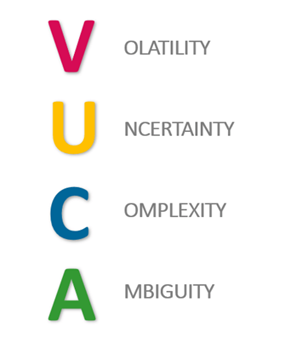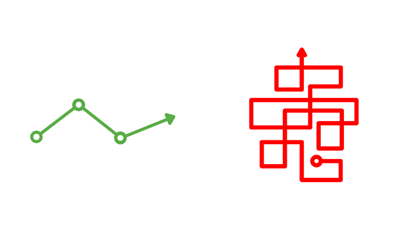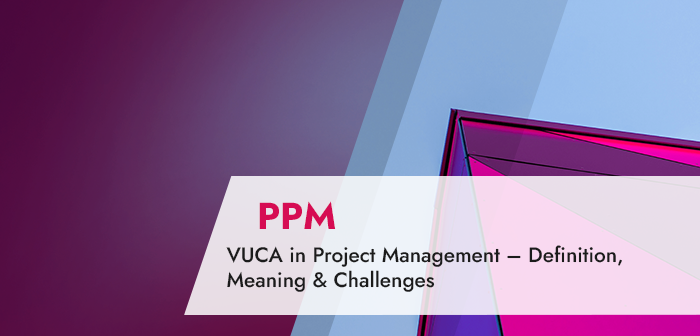The term VUCA has its origins in the American military. From there, it spread to other areas of strategic leadership in organizations. Project management is a key approach to handling the challenges of the VUCA world in the business environment better. However, to be truly successful, the approach to project management must change significantly compared to the past. In this article, you will learn what you have to take into account.
These are the topics:
- What is VUCA?
- What does VUCA have to do with project management?
- What is the best way to address VUCA?
- In detail: VUCA in project management
- What skills do you need in the VUCA world?
- Conclusion
What Is VUCA?
VUCA is an acronym and stands for:
- Volatility
- Uncertainty
- Complexity
- Ambiguity

These four dimensions describe the challenges companies and organizations are facing nowadays. Executives, project managers and all employees in general must cope in the face of these drastically changed circumstances.
Before addressing the challenges of VUCA in detail, we will answer the question of what VUCA has to do with project management.
What Does VUCA Have to Do with Project Management?
Project management is no longer what it was 20 years ago. The pressures of the VUCA world – on all of us – have increased. In today’s digital age, we are constantly confronted with change. For instance, many companies are under constant pressure to innovate. In addition:
- Competition is ever tougher
- Resources are scarcer than before
- Stakeholders / Customers are more demanding
The state of the world – volatile, uncertain, complex and ambiguous – also impacts how projects are delivered under these circumstances. In these more challenging times, those in charge of projects must always hold the reins to guide their projects to the finish line, even as circumstances change. This calls for project management – without VUCA you probably would not need project management either :-).
What Is the Best Way to Address VUCA?
The likelihood of overwhelming individuals or even whole companies has become very high in the VUCA world. We cannot continue to do business as usual, since VUCA has become “usual” at this point. The four dimensions of VUCA are meant to illustrate what is no longer “normal” We will get to that in a minute.
For now, here is a recommendation of how to best address the VUCA world.
- The VUCA world is reality!
- Everyone has to accept this for themselves.
- Resignation will not help; everyone has to actively face this issue.
- How do you face this world? Be honest when dealing with other people. There is no shame for anyone in admitting to not knowing. Nobody can know everything in these times.
To better cope with the VUCA world, a change in culture is needed in companies. People must be permitted to no longer know everything.
According to the “Fail Cheap” principle, employees should be encouraged by their superiors to tell them early on that they do not know something. This reduces project costs, as mistakes are identified at an early stage making it possible to react to them.
It also reduces stress for every individual (“who thinks they are meant to know everything at all times but cannot”), because communication is open.
The results of the change in culture:
- The weight of expectations is lowered
- Employees stay healthier
- They stay with the company for longer
- Project costs are lower
In Detail: VUCA in Project Management
Volatility
There are many more changes in projects than in the past. The environment changes faster – it is more volatile. Reason for this are for example:
- Trends and wealth of new technologies
- More dynamic competitive and market environment
- High turnover of employees coupled with the associated loss of knowledge
As a result of globalization (keyword: global suppliers) and digitization (software can be developed faster than hardware), prioritization in long-running projects becomes more and more difficult.
Volatility makes it increasingly difficult to differentiate between the urgent and the important.

An Example:
Global interconnectedness carries volatility. Volatile markets change unpredictably and quickly. One of the VUCA examples that increasingly causes volatility is technological progress. Thus, more and more products are characterized by their software which can be developed much faster than hardware. We can observe this with cars, for example. Today, they can be updated with new vehicle control functions via radio.
Our tip: As a project manager, you are forced to deal with more and more changes. You should be transparent about communicating these and document the changes properly compared to the original order as part of after-sales management. This is more important today than in the past. Plus: in this environment, agile mindset and methods continue to gain importance. Get yourself up to speed in this area.
Special Download: Agile, Traditional or Hybrid Project Management? (PDF file)
Please fill in the form.
* Required Fields | Data Protection
Uncertainty
Previously, it was easier for individuals with a lot of experience to “predict” the future, i.e., to create project plans that were very accurate in terms of task duration, effort and cost. However, the problem we encounter nowadays is that the circumstances in which experience was gained in the past are often obsolete for the future (e.g., due to changes in the technological environment). Therefore, figures based on previous experience are useful as a decision-making basis only to a limited extent – which leads to much more uncertainty.
Nobody knows when changes or challenges will arise. The higher the lack of knowledge and information, the higher the uncertainty. It is linked to difficult decision-making and plannability. Good risk management can remedy this. It is becoming more and more important to address this.

An Example:
There are many things which are being done for the first time today due to rapid change in the global environment – because they are new. For instance, if you have carried out five similar development projects in the last ten years, you can only set out on the sixth project starting today with a higher uncertainty than would have previously been the case. Influencing factors can be available resources, disrupted supply chains or changing technologies. Sound risk management is essential today.
Our tip: Practice good risk management and always have a Plan B up your sleeve. To make sure you know what is coming, you should try to identify or learn about risks yourself at an early stage with open eyes and transparent communication with your informed environment.
Further reading: Risk Management in Project Management – How to Do It Right
And another tip: Account for the novelty before the project start by:
- Classifying the project (what type of project?)
- Selecting the project manager (experience with similar projects / technologies)
- Putting together the project team (openness to new things)
- Rating the planning quality (using planning categories)
The predictability of project results is lower than in the past despite sound planning. You have to deal with this openly. Hence, you should differentiate the following categories when planning:
- Exactly what I have done before
- Not what I have done before, but I know whom to ask
- Not what I have done before, and I am unsure if it is feasible at all
Complexity
The number of influencing factors has increased significantly in the project environment. The share of electronics and software is increasing at an incredible rate. Many mechanical things can be seen and grasped, but this is not true of a lot of software solutions – they are a black box for many people. This means connections often go unidentified, and accordingly planning is difficult. As a result, problems are only identified when they arise, not during planning.

An Example:
In many areas, technology and software are becoming increasingly important. Companies hire many new professionals for this, but they often only cover small technical areas. Managers are expected to coordinate the ever-growing number of “puzzle pieces” in projects. This leads to complexity in the solution and the number of project participants and thus higher demands in communication. The result: there are fewer and fewer people who actually have an overview of everything.
Our tip: Since the project environment is becoming increasingly complex, you need experts. However, make sure you also have particularly capable individuals who will bring these experts together. In these meetings, you need to discuss mutual interdependencies and work out the feasibility of solutions as a team. In this way, you ascertain three things:
- Nothing is overlooked
- Projects are not severely delayed
- Projects do not fail
Ensure that the “big picture” is taken into account despite the complex technical details – by asking, asking, asking.
Ambiguity
Situations, information and events, such as project results, can be interpreted in many different ways. What does “done” mean in a digital world? The “done” is not immediately visible because the hardware may look done, even as the corresponding software is not yet fully functional. Therefore, the conditions need to be defined via states more clearly than in the past.
An Example:
In today’s complex project environment, it is harder to get a precise statement in response to simple questions. “How far along are you?” “When will you be done?” “How much will it cost?” All these questions are harder to answer than in the past. Different people will respond differently from their respective perspectives, as things are so complex (many more influencing factors) and hardly anyone has a complete overview. Contradictions are also part of the game. For every opinion backed up by experience, you will find a valid counter-opinion nowadays.
Our tip: Due to the risk of ambiguity, you as a project manager need to document your decisions and the determining factors for your decisions better than in the past. This will allow you to prove that your decision was reasonable at the time it was made. In addition, make sure you have defined clearly, in terms of the “Definition of Done”, at what point a solution or a part of it is actually done.
What Skills Do You Need in the VUCA World?
Agile Mindset
If you are faced with changes in the framework environment and scope during the course of a project, adaptability is what is needed. Over the past few years, agile or hybrid project management methods have become more and more established in this context. They also include careful stakeholder management to enable adequate consideration of the changing requirements of customers. Communication is becoming much more important.
Another interesting read: Hybrid Project Management: Combining Agile & Traditional
Change Management
People have a hard time with change, especially when they do not understand the reason for it. This is where change management methods come into play. Applied correctly, change management leads to more appreciation and sustained acceptance among employees – in the project as well as in the company as a whole. This is why project managers must have change management skills. Sometimes, the issue is not the change itself but only the excessive speed of the change, which causes defensiveness. You have to be prepared for this.
Further reading here: Change Management in Projects for Project Managers
Cultural Change in Companies
A VUCA environment may no longer allow you to manage teams efficiently from the top. Therefore, we need a cultural change among managers and companies in general. For superiors, this includes encouraging employees according to the “Fail Cheap” principle to tell them early on that they do not know something. Flat hierarchies as well as the ability of superiors to let agile teams make their own decisions and take responsibility are also beneficial. However, not all team members will want to take on more responsibility. So, be careful when granting more self-determination – not everyone is able or willing to handle this well. With support, this will certainly work better than on one’s own.
Project Vision
What is the goal of your project, and what would you like to achieve with the project in the long term? Project managers at your company should develop a vision for this and communicate it to the employees in the project environment. This does not mean a detailed specification but rather a description of the benefits the results of the project are meant to provide (see also our article on the meaning of project success). It will support the motivation to stay the course, even in the face of constantly changing circumstances.
Reading tip: Project Success – Definition, Challenges, Tips
Conclusion – VUCA in Project Management
In this article, you have learned about the meaning of VUCA in project management and how this new VUCA world impacts project managers. We cannot continue to do business as usual, since VUCA has become “usual” at this point.
Project management is becoming more and more important in this VUCA world. However, project managers have to change their working methods significantly compared to the past. After all, the existing body of experience is often no longer applicable to the new environment.
They must remain flexible. Everyone must accept for themselves that we are living in the changed VUCA world and actively face this issue. This requires a change in culture in companies. People must be permitted to no longer know everything.
Project managers must ensure that there is constant communication between the experts in all areas in order to keep track of the “big picture” as much as possible. To this end, the most important thing in dealing with each other is: ask, ask ask.
Our final tips
Get to know the individually adaptable “PPM Paradise” – the optimal environment for your enterprise-wide project, program, portfolio and resource management. Download the eBook now (just click, no form).
And sign up for our bi-weekly blog newsletter to make sure you receive all our updates.
Has this article been helpful to you? If so, help us improve our reach and share the post with your network. Thank you. And if there are any other terms you would like us to cover – please write to us! We will be happy to address your suggestion in the next article.
Subscribe to TPG BlogInfo: Never miss new practice-oriented tips & tricks
Every other week: Receive practical tips in TPG blog posts written by recognized experts in project, portfolio, and resource management.
* Required Fields | Data Protection
 Johann Strasser
Johann Strasser
The certified engineer has been a managing partner at TPG The Project Group since 2001
After many years as a development engineer in the automotive and energy sectors, Johann Strasser spent a decade as an independent trainer and consultant in the field of project management. During his tenure, he also served as project manager for software projects in the construction industry and provided scheduling and cost management support for large-scale construction projects. At TPG, he applies his expertise in product development and consulting services for international clients. His special focus is on PMO, project portfolios, hybrid project management, and resource management. For many years now, he has shared his knowledge through presentations, seminars, articles, and webinars.
 Anna Pauels
Anna Pauels
Content Marketing Professional
Anna has worked as a content creator for the TV stations ARD and ProSieben, as well as newspapers such as Münchner Merkur and tz, and numerous lifestyle magazines. Today, Anna Pauels is part of the Marketing team at TPG The Project Group, handling the German, English, and French versions of the blog as well as the social media channels and the monthly newsletter.







